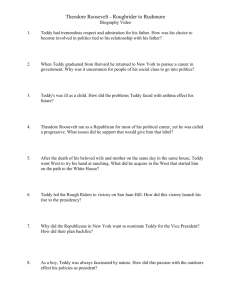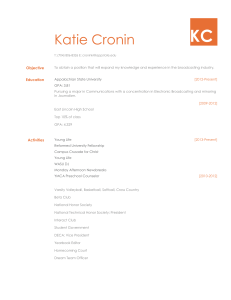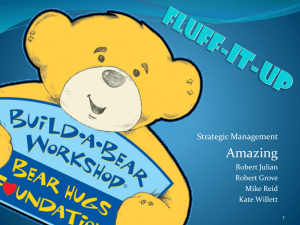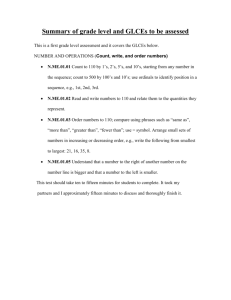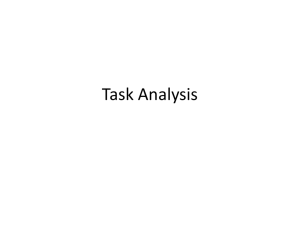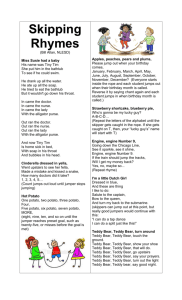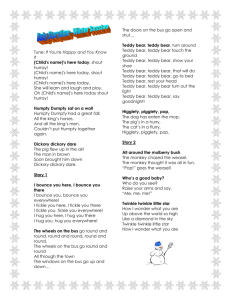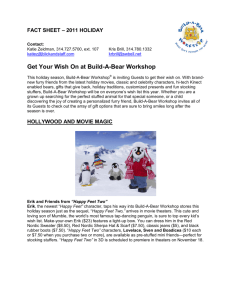“Build-a-Bear” Unit Plan
advertisement
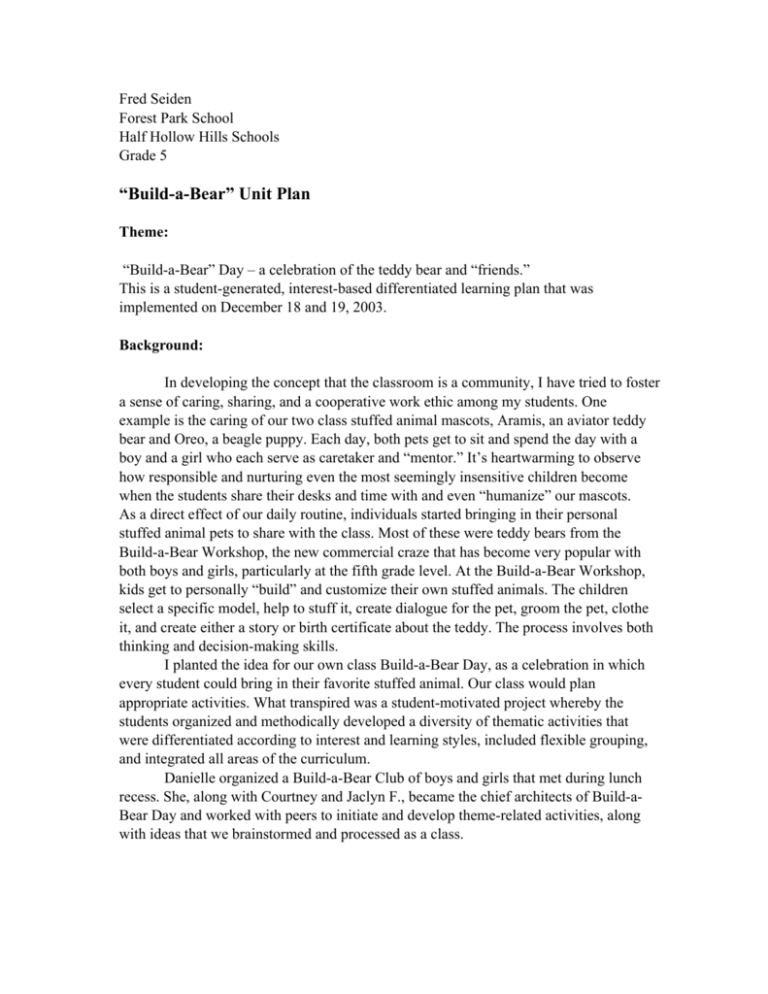
Fred Seiden Forest Park School Half Hollow Hills Schools Grade 5 “Build-a-Bear” Unit Plan Theme: “Build-a-Bear” Day – a celebration of the teddy bear and “friends.” This is a student-generated, interest-based differentiated learning plan that was implemented on December 18 and 19, 2003. Background: In developing the concept that the classroom is a community, I have tried to foster a sense of caring, sharing, and a cooperative work ethic among my students. One example is the caring of our two class stuffed animal mascots, Aramis, an aviator teddy bear and Oreo, a beagle puppy. Each day, both pets get to sit and spend the day with a boy and a girl who each serve as caretaker and “mentor.” It’s heartwarming to observe how responsible and nurturing even the most seemingly insensitive children become when the students share their desks and time with and even “humanize” our mascots. As a direct effect of our daily routine, individuals started bringing in their personal stuffed animal pets to share with the class. Most of these were teddy bears from the Build-a-Bear Workshop, the new commercial craze that has become very popular with both boys and girls, particularly at the fifth grade level. At the Build-a-Bear Workshop, kids get to personally “build” and customize their own stuffed animals. The children select a specific model, help to stuff it, create dialogue for the pet, groom the pet, clothe it, and create either a story or birth certificate about the teddy. The process involves both thinking and decision-making skills. I planted the idea for our own class Build-a-Bear Day, as a celebration in which every student could bring in their favorite stuffed animal. Our class would plan appropriate activities. What transpired was a student-motivated project whereby the students organized and methodically developed a diversity of thematic activities that were differentiated according to interest and learning styles, included flexible grouping, and integrated all areas of the curriculum. Danielle organized a Build-a-Bear Club of boys and girls that met during lunch recess. She, along with Courtney and Jaclyn F., became the chief architects of Build-aBear Day and worked with peers to initiate and develop theme-related activities, along with ideas that we brainstormed and processed as a class. Page 2 Goals According to the NYS Standards: ELA The students will read, write, listen, and speak for information and understanding. Students will read, write, listen, and speak for literary response and expression. Students will read, write, listen, and speak for critical analysis and evaluation. Students will read, write, listen, and speak for social interaction. Math, Science, and Technology: Students will use math analysis, scientific inquiry, and engineering design, as appropriate, to pose questions, seek answers, and design solutions. Students will access, generate, process, and transfer information using appropriate technologies. Students will understand and apply math in real world settings. Students will understand and apply scientific concepts, principles, and theories to the physical and living environment. Students will apply technological knowledge and skills to design, construct, use, and evaluate products and systems to satisfy human and environmental needs. Students will understand the relationships and common themes that connect math, science, and technology and apply the themes to these and other areas of learning. Social Studies: Students will use a variety of intellectual skills to demonstrate their understanding of major ideas, eras, themes, and developments in the history of the United States and New York. Students will use a variety of intellectual skills to demonstrate their understanding of major ideas, eras, themes, developments, and turning points in world history and examine the broad sweep of history from a variety of perspectives. Students will use a variety of intellectual skills to demonstrate their understanding of the geography of the independent world in which we live – local, national, and global – including the distribution of people, places, and environments over the Earth’s surface. The Arts: Students will actively engage in the processes that constitute creation and performance in the arts and participate in various roles. Students will be knowledgeable about and make use of the materials and resources available for participation in the arts in various roles. Page 3 The students will know: how the teddy bear got its name. how the teddy bear developed in both Germany and the United States. that bears have played important roles in literature, television, and motion pictures. that Teddy Roosevelt was a President of firsts: the first to own a car, to fly in a plane, to submerge in a submarine, to win the Nobel Peace Prize. the meanings of centennial and conservation. certain historical facts that correlate with each of the decades of the teddy bear centennial. the species of stuffed animals, besides teddy bears, that belong to the Build-a-Bear family. how to download and use information from the Build-a-Bear website. how to use Inspiration and the Internet to download graphics and pictures that are relevant to their stuffed animals. how to classify their teddy bears (stuffed animals) based on specific criteria. how to use Oreo cookies and other specific foodstuffs to create edible craft projects. how to solve word and picture puzzles relevant to stuffed animals. how to explain the facets that make their stuffed animals dear to them. how to play individual and team thematic games that include computer games, pictionary, bear-of-fortune, teddy bear trivia, concentration, and numbearology. how to write interviews, biographies, autobiographies, or personal narratives about their selected stuffed animal. The students will understand: that toys are an important part of our culture that toys, specifically teddy bears and stuffed animals can play an integral part in children’s lives those teddy bears have an international appeal. that change and continuity are a part of the development and history of the teddy bear and stuffed animals. cooperation among peers is essential if a class is to organize, develop, share, and execute group learning activities and positive social experiences. that a class functions as a community. Page 4 The students will be able to: compare and contrast the historical development of the teddy bear in Germany and America. play and participate in board games, computer games, and paper games relevant to the Build-a-Bear theme. write and perform a choral reading. prepare individual oral presentations to the class that describe their stuffed animals and articulate how the animals are dear to them. write personal narratives, biographies, autobiographies, and/or interviews (the students will be given choices) follow written directions and create edible cookie crafts. work creatively and cooperatively to devise and develop thematic drawings, computer graphics, word and picture puzzles, games, relative to the Build-a-Bear celebration. classify their teddy bears (stuffed animals), as scientists, according to specific criteria. use listening skills to hear a read-aloud story about the history of the teddy bear, from the teddy’s perspective. As a result, the students will make comparisons/contrasts, analyze, and evaluate. to identify teddy bears from literature, movies, and television and explain how they are famous. construct a timeline of American historical events that correlate with the decades of the centennial of the teddy bear, as described in the Build-a-Bear website’s teddy bear history. construct questions for a teddy bear history trivia game, based on the Build-a-Bear website’s teddy bear history. navigate the Build-a-Bear website to download instructional information, games, and puzzles relative to the topic of teddy bears and stuffed animals. Page 5 Process: By consensus, the class decided to hold Build-a-Bear Day on Thursday, December 18. Any unfinished activities would carry over to Friday. This was appropriately timed with the general festive mood of the upcoming winter holiday vacation. Coincidentally, we learned that that the teddy bear centennial was still being celebrated. Build-a-Bear Day commenced with a choral reading that was written and performed by the Build-a-Bear club. The presentation served as an overture to the day’s activities, introducing six differentiated activity centers and flexibly-grouped teams. Each team was to spend about fifteen minutes at each station and then rotate. Once all of the activities were completed, the Build-a-Bear club “actors” would meet again and perform a finale which would serve as a lead-in for a small holiday snack festival. Below is a description of each activity station. Station #1: Oreo Creations Both Danielle and David created cookie craft recipes. In one recipe, the kids concocted winter scenes while the second recipe called for the creation of cookie bunnies. Both recipes used Oreos, marshmallows, M&M’s, frosting, and candy corns. The students followed written directions and got to enjoy their edible their finished products. Station #2: The Bear of Fortune Game Show Alex developed this game, based on TV’s Wheel of Fortune. Three contestants from each team competed to guess originally-developed phrases based on the following thematic categories: bear phrases, famous bears, our class bears, and catch phrases. The winner of each segment received class lotto tickets good for prizes at day’s end. Station #3: Teddy Bear Trivia Danielle developed a trivia game in which two contestants from each team competed to answer questions about the history of the teddy bear. The history was downloaded from the internet and read, in advance, by each student who played. The winner of each set qualified to compete in the “championship.” Page 6 Station #4: Board Games – Pictionary and Scrabble Each student in the class wrote the title of a picture to draw. The pictures were related to either the teddy bear theme or to daily class activities. One student would randomly select a picture to draw that the other group members had to guess. In the scrabble game, the students would get extra points for devising words related to the teddy bear theme. Station #5: Puzzles and Paper and Pencil Activities: Students composed thematic word puzzles, word searches, and picture puzzles. Danielle, Courtney, and Jaclyn F. obtained commercially-prepared games from the Builda-Bear Workshop that included “Numbearology,” a math game, “The Great Fur Find,” a word search, “Bear Voyage,” a maze, and “The Message is Fuzzy,” deciphering codes – bearoglyphics. Station #6: Multi-curricular Games, Arts and Crafts, Literature, History and “Bearitage” The team at this station logged-on to www.build-a-bear.com and could download any of the following programs. The games can be geared to difficulty levels. Teddy Roosevelt Storybook (a biography) Centennial Puzzle Bearitage – Teddy Bear Centennial Historic Facts Concentration- Matching International Flags U.S. Geography Puzzle Mad Libs Math Flash Cards (the four operations) Arts and Crafts (a T. Roosevelt mask for child and bear, teddy bear centennial cards, design and print bookmarks) Pie-Eating Contest Picture Puzzles Page 7 Whole Class Activities: Oral Presentations – Each student had their picture taken with their stuffed animal prior to giving an oral presentation to class. In their presentation, each child informed the class how they obtained their pet and how their teddy or stuffed animal was important. The audience was allowed to respond by asking questions. Writing Workshop – After a mini-lesson and some brainstorming, the students were given the following choices to write about: Write a personal narrative about your stuffed animal Write a biography or autobiography about your stuffed animal Interview your stuffed animal Science – Each student was assigned to classify and describe their stuffed animals according to specific categories that included species, size, shape, color and design, texture, natural attributes, and accessories Read-Aloud – Read A Tale of Two Teddies by Kathleen Bart, a picture book that tells the history of the teddy bear from the perspective of the teddy, one from Germany and one from the U. S. The students can become involved in shared inquiry, make comparisons and contrasts, evaluate, and make decisions. Page 8 Assessment: Ongoing student observation, monitoring, and evaluation during group and individual activities Follow-Up: A possible follow-up would be for our class to register and participate in The Teddy Bear Project, an international exchange program that teams pairs of schools. Classes in the two schools exchange a teddy bear or other soft toy. The bear will document its daily activities, trips, home visits, social events, and adventures in a diary that will be e-mailed home. The project aims to foster and enhance an understanding and acceptance of different cultures. Resources: The Internet: HYPERLINK "http://www.build-a-bear.com" www.build-a-bear.com HYPERLINK "http://www.teddies-world.net" www.teddies-world.net HYPERLINK "http://www.iearn.org.au/tbear/" www.iearn.org.au/tbear/ HYPERLINK "http://www.theteddybearmuseum.com" www.theteddybearmuseum.com A Tale of Two Teddies: The First Teddy Bears Tell Their Stories by Kathleen Bart

